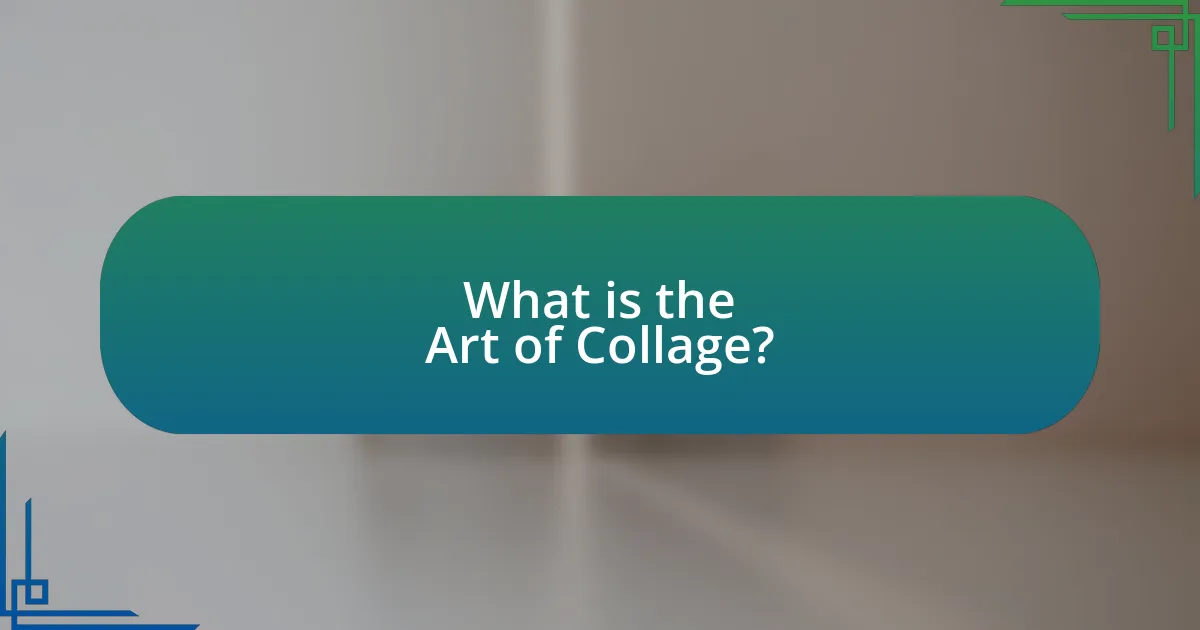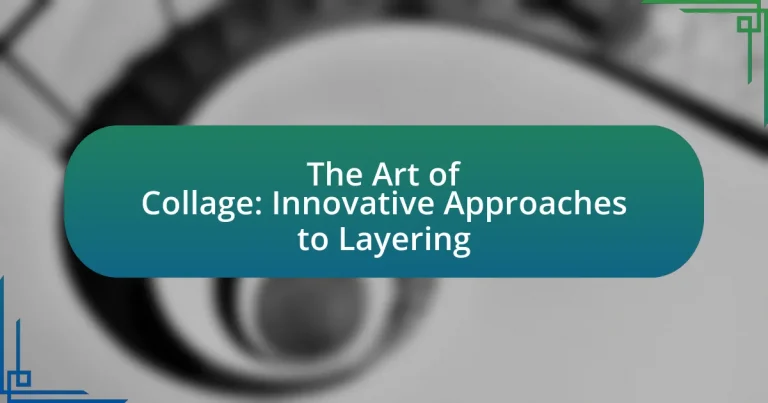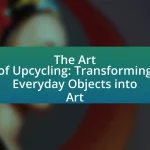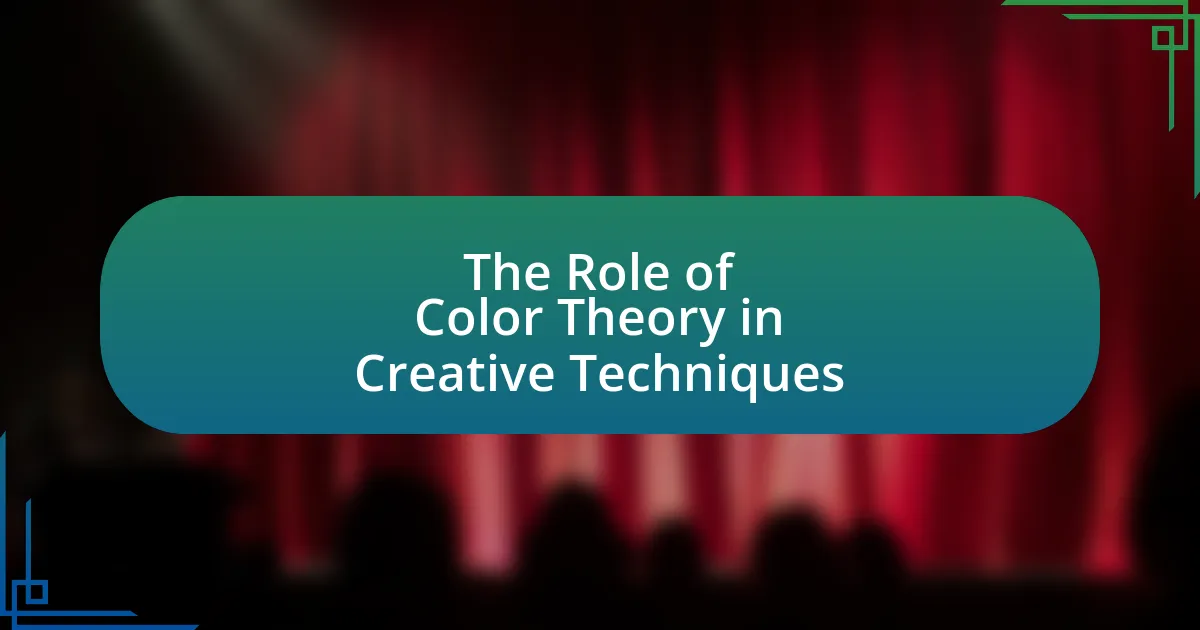The Art of Collage is a creative technique that involves assembling various materials, such as photographs, paper, and fabric, to create unified artworks. Originating in the early 20th century, collage was pioneered by artists like Pablo Picasso and Georges Braque within the Cubist movement, and has since evolved through influences from Dadaism and Surrealism. This article explores the fundamental techniques of collage, including layering and composition, the materials commonly used, and innovative approaches that incorporate digital technology. Additionally, it discusses the practical applications of collage techniques in education, therapy, and advertising, as well as resources for learning more about this versatile art form.

What is the Art of Collage?
The Art of Collage is a creative technique that involves assembling various materials, such as photographs, paper, fabric, and other objects, to create a unified artwork. This method allows artists to explore themes, juxtapose different elements, and convey complex narratives through the layering of diverse textures and images. Historically, collage emerged in the early 20th century, with notable artists like Pablo Picasso and Georges Braque pioneering its use in Cubism, demonstrating its potential to challenge traditional artistic boundaries and engage viewers in new ways.
How did the art of collage originate?
The art of collage originated in the early 20th century, primarily associated with the Cubist movement led by artists like Pablo Picasso and Georges Braque. These artists began incorporating various materials such as paper, fabric, and found objects into their works, breaking traditional boundaries of painting. The term “collage” itself derives from the French word “coller,” meaning “to glue,” reflecting the technique’s emphasis on assembling disparate elements. This innovative approach allowed for new forms of expression and challenged conventional artistic practices, paving the way for future movements such as Dada and Surrealism, which further explored the juxtaposition of images and materials.
What historical movements influenced the development of collage?
The development of collage was influenced by several historical movements, primarily Cubism, Dadaism, and Surrealism. Cubism, pioneered by artists like Pablo Picasso and Georges Braque in the early 20th century, introduced the idea of fragmented forms and multiple perspectives, which laid the groundwork for collage techniques. Dadaism, emerging during World War I, embraced randomness and absurdity, encouraging artists to incorporate found objects and materials into their work, as seen in the works of Marcel Duchamp. Surrealism further expanded collage by integrating dream-like imagery and unexpected juxtapositions, as exemplified by artists like Max Ernst. These movements collectively shaped the evolution of collage as a distinct art form, emphasizing innovation and the recontextualization of everyday materials.
Who are some key figures in the history of collage?
Key figures in the history of collage include Pablo Picasso, Georges Braque, and Hannah Höch. Pablo Picasso and Georges Braque pioneered the technique in the early 20th century, particularly within the Cubist movement, where they incorporated materials like newspaper and wallpaper into their works. Hannah Höch is recognized for her contributions to photomontage, particularly in the Dada movement, where she used collage to critique societal norms and gender roles. These artists significantly shaped the evolution of collage as a legitimate art form, influencing countless others in the process.
What are the fundamental techniques used in collage?
The fundamental techniques used in collage include layering, cutting, and adhering various materials such as paper, fabric, and photographs. Layering involves placing different elements on top of each other to create depth and visual interest, while cutting allows artists to manipulate shapes and forms from the source materials. Adhering is the process of securely attaching these elements to a base, often using glue or other adhesives. These techniques enable artists to combine diverse textures and images, resulting in unique compositions that convey complex narratives or emotions.
How do layering and composition play a role in collage creation?
Layering and composition are fundamental to collage creation as they determine the visual hierarchy and narrative structure of the artwork. Layering involves the strategic placement of various materials, such as paper, fabric, or photographs, to create depth and texture, which enhances the overall aesthetic appeal. Composition refers to the arrangement of these layers, guiding the viewer’s eye and establishing focal points within the piece. Effective composition can evoke emotions and convey messages, as seen in the works of artists like Hannah Höch, who utilized layering and composition to challenge societal norms. Thus, the interplay of layering and composition is essential for achieving a cohesive and impactful collage.
What materials are commonly used in collage art?
Collage art commonly utilizes materials such as paper, photographs, fabric, and found objects. These materials allow artists to create layered compositions by combining different textures and visual elements. For instance, paper can include magazine clippings, newspapers, or handmade paper, while photographs can be sourced from personal collections or printed images. Fabric adds tactile quality, and found objects, like buttons or leaves, introduce three-dimensional aspects. The versatility of these materials contributes to the unique aesthetic and expressive potential of collage art.
Why is collage considered an innovative art form?
Collage is considered an innovative art form because it combines diverse materials and techniques to create new meanings and perspectives. This method allows artists to break traditional boundaries of art by integrating photography, painting, text, and found objects, thus challenging conventional notions of representation. Historically, artists like Pablo Picasso and Georges Braque pioneered collage in the early 20th century, demonstrating its potential to transform everyday materials into profound artistic statements. The ability to juxtapose contrasting elements fosters a dialogue between different contexts, making collage a dynamic medium that reflects contemporary culture and thought.
How does collage challenge traditional artistic boundaries?
Collage challenges traditional artistic boundaries by integrating diverse materials and techniques, allowing for a multi-dimensional expression that defies conventional painting or sculpture. This medium combines elements such as photographs, fabric, and found objects, creating a dialogue between disparate sources that traditional art forms typically do not permit. For instance, artists like Pablo Picasso and Georges Braque pioneered collage in the early 20th century, breaking away from realism and embracing abstraction, which fundamentally altered perceptions of art. The use of everyday materials in collage democratizes art, making it accessible and reflective of contemporary life, thus reshaping the criteria for what constitutes art.
What unique perspectives does collage offer to artists and viewers?
Collage offers artists and viewers a multifaceted perspective by combining disparate elements into a cohesive whole, allowing for the exploration of themes such as identity, memory, and cultural commentary. This technique encourages artists to juxtapose various materials, which can lead to unexpected interpretations and emotional responses. For instance, the use of found objects and images can challenge traditional notions of authorship and originality, as seen in the works of artists like Pablo Picasso and Hannah Höch, who utilized collage to critique societal norms and express complex narratives. This layering of visual information invites viewers to engage actively with the artwork, prompting them to decipher meanings and connections that may not be immediately apparent.

What are Innovative Approaches to Layering in Collage?
Innovative approaches to layering in collage include the use of mixed media, digital integration, and three-dimensional elements. Mixed media layering involves combining various materials such as paper, fabric, and found objects to create texture and depth, enhancing visual interest. Digital integration allows artists to incorporate digital images and graphics, enabling more complex compositions and the ability to manipulate layers easily. Three-dimensional elements, such as pop-ups or sculptural components, add physical depth and engage viewers in a tactile experience. These methods reflect contemporary trends in collage, emphasizing creativity and experimentation in visual art.
How can layering techniques enhance the visual impact of a collage?
Layering techniques enhance the visual impact of a collage by creating depth and complexity, which draws the viewer’s eye and encourages exploration of the artwork. By overlapping various materials, such as images, textures, and colors, artists can establish a multi-dimensional effect that adds interest and intrigue. This method allows for the juxtaposition of contrasting elements, which can evoke emotional responses and convey deeper meanings. Research in visual perception indicates that layered compositions can increase engagement, as viewers are more likely to spend time analyzing the relationships between the different layers, thus enhancing their overall experience of the artwork.
What are some advanced layering methods used by contemporary artists?
Contemporary artists utilize advanced layering methods such as digital layering, mixed media techniques, and transparent materials. Digital layering involves the use of software to combine various images and textures, allowing for intricate compositions that can be easily manipulated. Mixed media techniques incorporate diverse materials like paint, paper, and fabric, enabling artists to create depth and texture through physical layering. Transparent materials, such as acrylic sheets or glass, are often used to add dimensionality and complexity to artworks, allowing viewers to see multiple layers simultaneously. These methods reflect the evolution of collage in contemporary art, emphasizing innovation and experimentation.
How does the choice of materials affect layering in collage?
The choice of materials significantly affects layering in collage by determining texture, weight, and visual impact. Different materials, such as paper, fabric, or found objects, influence how layers interact; for instance, heavier materials can create depth and stability, while lighter materials may allow for more delicate arrangements. Additionally, the surface characteristics of materials, like glossiness or roughness, can alter how light interacts with the collage, affecting the overall aesthetic. Research indicates that the combination of various materials can enhance visual complexity, as seen in the works of artists like Robert Rauschenberg, who utilized diverse materials to create dynamic layers that engage viewers.
What role does digital technology play in modern collage layering?
Digital technology plays a crucial role in modern collage layering by enabling artists to manipulate images with precision and ease. This technology allows for the seamless integration of various media, including photographs, illustrations, and textures, facilitating complex layering techniques that were previously labor-intensive or impossible. For instance, software like Adobe Photoshop provides tools for digital layering, such as masks and blending modes, which enhance the creative possibilities for artists. Additionally, the ability to work in a non-destructive manner allows for experimentation without the risk of permanently altering original images, thus fostering innovation in collage art.
How can digital tools be used to create layered collages?
Digital tools can be used to create layered collages by allowing users to manipulate images, text, and graphics on multiple layers within software applications. Programs like Adobe Photoshop and Canva enable artists to import various elements, adjust their opacity, and arrange them in a visually appealing manner. These tools provide features such as layer masks, blending modes, and filters, which enhance the depth and complexity of the collage. For instance, Photoshop’s layering system allows for precise control over each element, facilitating intricate designs that can be easily edited or rearranged.
What are the benefits of combining traditional and digital collage techniques?
Combining traditional and digital collage techniques enhances creativity and expands artistic possibilities. This integration allows artists to leverage the tactile qualities of physical materials while utilizing the precision and versatility of digital tools. For instance, traditional techniques can introduce unique textures and organic elements, while digital methods enable easy manipulation, layering, and editing of images. This combination fosters innovative compositions that can be difficult to achieve through either method alone, resulting in a richer visual experience. Additionally, artists can reach broader audiences by sharing their hybrid works online, thus increasing visibility and engagement with their art.

What are the Practical Applications of Collage Techniques?
Collage techniques have practical applications in various fields, including education, therapy, and advertising. In education, teachers use collage to enhance creativity and critical thinking skills among students by allowing them to express ideas visually. In therapy, art therapists employ collage as a tool for self-expression and emotional exploration, helping individuals process feelings and experiences. In advertising, marketers utilize collage techniques to create visually compelling campaigns that capture attention and convey messages effectively. These applications demonstrate the versatility of collage techniques across different domains, reinforcing their value in fostering creativity and communication.
How can artists apply innovative layering techniques in their work?
Artists can apply innovative layering techniques in their work by integrating various materials and mediums to create depth and texture. For instance, they can combine traditional paint with digital elements, such as printed images or textures, to enhance visual complexity. This approach allows for the exploration of mixed media, where artists can utilize transparent layers of acrylics or watercolors over photographs or textured papers, resulting in a multidimensional effect. Historical examples include the works of Robert Rauschenberg, who famously used found objects and silkscreen printing to create layered compositions that challenge conventional boundaries of art. Such techniques not only enrich the visual experience but also invite viewers to engage with the artwork on multiple levels.
What tips can help beginners effectively layer materials in collage?
To effectively layer materials in collage, beginners should start by selecting a focal point that will guide their composition. This focal point can be an image or a texture that draws attention and serves as the base layer. Next, beginners should experiment with varying the size and shape of materials, as this creates visual interest and depth. Additionally, using transparent or semi-transparent materials allows for overlapping effects that enhance the layering process.
To reinforce these techniques, studies in visual arts emphasize the importance of contrast and balance in composition, which can be achieved by layering different textures and colors strategically. For instance, contrasting rough and smooth surfaces can create a dynamic visual experience. By following these tips, beginners can develop their skills in layering materials effectively in collage.
How can artists overcome common challenges in collage layering?
Artists can overcome common challenges in collage layering by employing strategic planning and experimentation with materials. By carefully selecting and arranging elements before adhering them, artists can visualize the final composition and address issues such as balance and contrast. Additionally, using transparent materials or varying textures can enhance depth and interest, allowing for more dynamic layering. Research indicates that artists who engage in iterative processes, such as creating multiple drafts or mock-ups, often achieve more cohesive and visually appealing results in their collages.
What are some examples of successful collage projects that utilize innovative layering?
Successful collage projects that utilize innovative layering include the works of artist Robert Rauschenberg, particularly his “Combines” series, which merges painting and sculpture through the use of found objects and layered materials. Another example is the work of Hannah Höch, who is known for her pioneering photomontages that combine various images and textures to create complex narratives. Additionally, contemporary artist Julie Mehretu employs layering in her large-scale works, integrating maps, architectural drawings, and abstract forms to explore themes of geography and history. These projects exemplify innovative layering techniques that enhance visual depth and meaning in collage art.
How do these projects inspire new approaches to collage art?
These projects inspire new approaches to collage art by integrating diverse media and contemporary themes, thus expanding the traditional boundaries of the medium. For instance, artists are increasingly incorporating digital elements, found objects, and mixed media techniques, which allow for greater experimentation and personalization in their work. This evolution is evidenced by the rise of artists like Hannah Höch and Romare Bearden, who utilized collage to comment on social issues and cultural identity, demonstrating that collage can serve as a powerful tool for storytelling and critique. Such innovative practices encourage emerging artists to explore new narratives and visual languages, ultimately redefining the possibilities within collage art.
What resources are available for learning more about collage techniques?
Books, online courses, and workshops are key resources for learning collage techniques. Notable books include “Collage: Contemporary Artists Hunt and Gather, Cut and Paste, Mash Up and Transform” by Danielle Krysa, which provides insights into modern collage practices. Online platforms like Skillshare and Udemy offer structured courses that cover various collage methods, allowing learners to engage with video tutorials and community feedback. Additionally, local art centers often host workshops that provide hands-on experience and guidance from experienced artists, enhancing practical skills in collage creation.
Where can artists find workshops or online courses focused on collage layering?
Artists can find workshops or online courses focused on collage layering through platforms such as Skillshare, Udemy, and Coursera. These platforms offer a variety of courses specifically designed for different skill levels, covering techniques and creative approaches to collage layering. For instance, Skillshare features classes taught by experienced artists, providing hands-on projects and community feedback, while Udemy offers structured courses with lifetime access to materials. Additionally, local art studios and community centers often host in-person workshops that focus on collage techniques, allowing for direct interaction with instructors and fellow artists.




